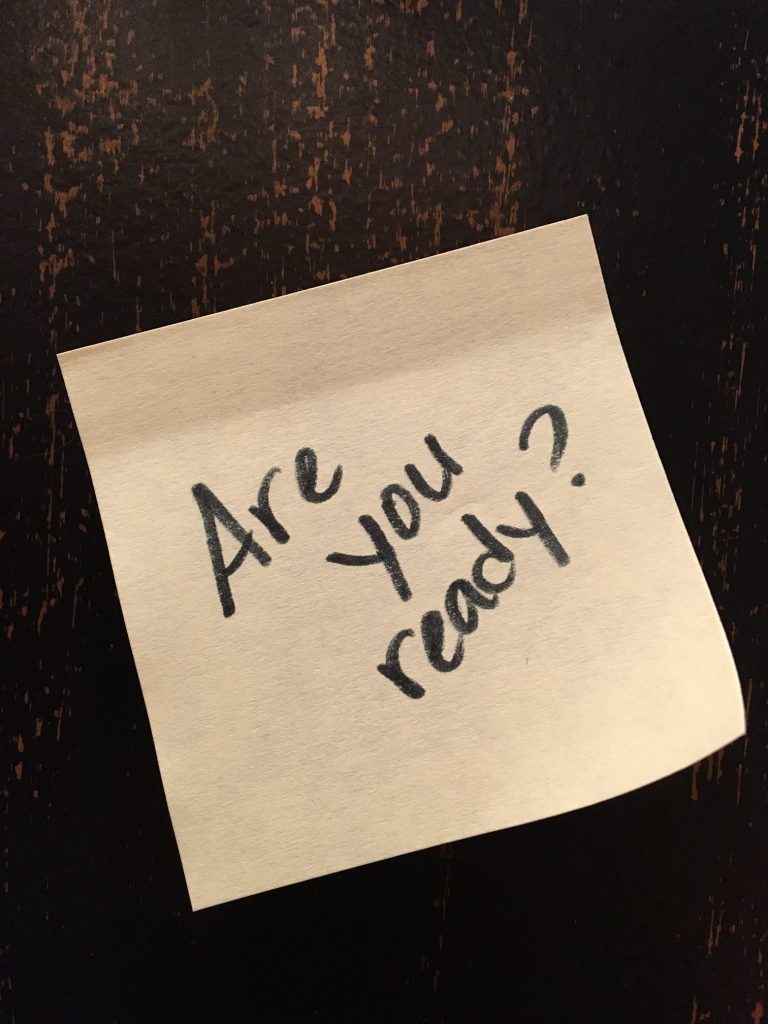
Jan 14, 2021 | Courage, Creativity, Intention, Leadership, Transition & Change, Truth
 We’ve been waiting. Waiting for 2020 to end and 2021 to finally arrive. But the turn of the calendar didn’t solve our problems – in fact, not much feels different at all. If anything, it feels like a continued or even an increased sense of unknown, uncertainty, and chaos.
We’ve been waiting. Waiting for 2020 to end and 2021 to finally arrive. But the turn of the calendar didn’t solve our problems – in fact, not much feels different at all. If anything, it feels like a continued or even an increased sense of unknown, uncertainty, and chaos.
Since March 2020, I’ve often felt like I’m in the middle of a dense forest with no obvious way out. My “way” has become one of putting one foot in front of the other, literally taking the next step, and then the next. Most days, this helps me feel like I’m making progress, albeit slow.
My consulting and executive coaching work focuses on helping leaders and their organizations navigate change and transition. These days, I lean on my own practices…a lot. One of my favorite sources is the work of William Bridges and the Bridges Transition Model. In his book, “Managing Transitions,” he presents the stages of transition: Letting Go, the Neutral Zone, and the New Beginning. Let’s take a look at the Neutral Zone he describes.
The Neutral Zone
“It’s a time when all the old clarities break down and everything is in flux. Things are up in the air. Nothing is a given anymore, and anything could happen. No one knows the answers: one person says one thing and someone else says something completely different.”
Sound familiar?
This Neutral Zone is a huge chasm of discomfort between an ending and a new beginning. We’re waiting – for a new president to take office, for spring to come, for a vaccine to be widely available, to return to school and work, to hug our friends and family, and to travel. Waiting, waiting, waiting. Telling yourself it’ll be worth the wait, but also feeling exhausted, isolated, and worried because time can feel like a finite resource.
Bridges continues, “One of the most difficult aspects of the Neutral Zone is that most people don’t understand it. They expect to be able to move straight from the old to the new. But this isn’t a trip from one side of the street to the other. It’s a journey from one identity to another, and that kind of journey takes some time. The attitudes, outlook, values, self-images, and ways of thinking that were functional in the past have to ‘die’ before people can be ready for life in the present.”
So, what do we do in this neutral zone? What do we do while we wait? How are you in this zone? Probably like you, one day I’m up, the next I’m down. Some days I’m optimistic, others, I can’t find that optimism no matter what I do or how hard I try.
But hang on…there’s hope!
As we’ve sustained in this abyss now for nearly 12 months, I’m learning to be with it and also recognize it for its gifts and opportunity. Somehow, it helps to know we’re all in it together…it literally feels like there’s not one person on the planet with a “ticket” to escape this time of pandemic, social and racial injustice and unrest, and political turmoil. We’re faced with doing our work and living our life the best we can. What feels most right to me is openness, kindness, compassion, flexibility.
“This is not the wasted time of meaningless waiting and confusion that it sometimes seems to be,” offers Bridges. “It’s a time when reorientation and redefinition must take place, and people need to understand that.”
Yes, it’s a time of anxiety and even chaos, but also it is a time when we’re more open to new ideas and opportunity. I remind myself daily that there’s power in this place. For me:
- Priorities have become clearer, and I realize what’s most important in my life.
- I can do with less. A lot less, in fact: money, material things, activities, work hustle…all the busyness
- Losing what “was” is teaching me to exercise my creativity and look for new opportunities to cultivate and apply myself – my interests, skills, talent, and experience. Coupling this with new insight around my priorities is giving way to a new and more aligned path.
- I’m reminded to celebrate the highs and the wins, even the smallest wins (especially those!)
- I look for the lessons in the lows and greatest challenges.
- I realize that my happiness and power come from within. I’m developing my spirituality practice to help me tap into that.
Since March, I’ve discovered that not only does my old way not work now, but I no longer even wish for that way. There are many things I quite like about this middle place and how the present is informing what I’m building. I’m learning to trust myself and my intuition and inner voice much more every day.
How are you finding ways to maximize and leverage your neutral zone?
 Hi, I’m Jeanie Duncan. I work with individuals and organizations as a transformation partner to help them unlock their Truth, discover authentic value, and create meaningful impact in the world. I believe when we are truly aligned with our purpose, we can live and perform at our highest potential. With over 25 years of experience as an executive, CEO, consultant, coach, and writer, I offer strategic, knowledgeable, and experienced guidance for those who are ready to take the courageous leap toward true transformation.
Hi, I’m Jeanie Duncan. I work with individuals and organizations as a transformation partner to help them unlock their Truth, discover authentic value, and create meaningful impact in the world. I believe when we are truly aligned with our purpose, we can live and perform at our highest potential. With over 25 years of experience as an executive, CEO, consultant, coach, and writer, I offer strategic, knowledgeable, and experienced guidance for those who are ready to take the courageous leap toward true transformation.

Jul 19, 2016 | Leadership, Transition & Change

In 2011, the Meyer Foundation and CompassPoint Nonprofit Services produced a research report “Daring to Lead” that surveyed 3,000 nonprofit executive directors and revealed a forecast of significant impending workplace transitions, with 67% of executives reporting that they expect to leave their jobs over the next five years.
Today, while we see many leadership transitions occurring among the Baby Boomer population, “what was once characterized as a pipeline problem can now be described as a bottleneck, as many individuals are choosing to work beyond the traditional retirement age due to a variety of reasons, including a prolonged economic recession,” reports the William and Flora Hewlett Foundation in “Moving Arts Leadership Forward.”
This reality requires organizations to examine its greatest asset – its people, their roles, and career paths – in strategic and creative ways. Workplaces can expect a robust boomer presence through at least 2034, when the youngest boomers will turn 70. This reality impacts Gen X-ers and Millennials aspiring to executive positions, where the wait time for succession is often longer than they would like.
While there was once a question of whether there were enough capable professionals to succeed an organization, now the challenge is more focused on developing and retaining early- and mid-career professionals in an environment of limited opportunities for formal advancement.
While not alone, nonprofits as a sector have considerable challenges in addressing this leadership reality, as they:
– Tend to be small-to-medium size operations and, as a result, are not likely to have as many resources to address strategy, planning, and leadership development.
– Are often institutions with a culture of group decision making, where business gets done through committees and boards of directors – a process that can create added delays and complexity.
– Can be highly funder-dependent, and any transition – especially with an organization’s top leadership – can threaten these vital relationships and the very future of the organization itself.
– Frequently are lead by an original founder or long-time executive. Over time, the top leader and the organization itself are inextricably connected. When this leader goes away, so could the organization.
– Often do not have sufficient reserves (if any at all) to weather an economic downturn, exposing the organization to significant financial vulnerabilities. Leadership transitions and professional development of its people, if not handled properly, can further intensify this situation.
– Sometimes have boards of directors who are unprepared to handle the transition and select and support new leaders. Despite over a decade of attention to this issue, executives and boards are still reluctant to talk proactively about succession, with just 17% reporting that their organizations had a written succession plan.
We must not overlook these pivotal leadership priorities for the development opportunities that they are. Properly and proactively managed, these changes and transitions provide an organization a period to pause, reflect, regroup, and focus. It’s a unique opportunity to examine strategic direction, priorities, and chart a future course. The key is not merely to endure it, but to emerge stronger and more dynamic from it.
You may be interested in these related blog posts:
Executive Leadership Transition and Organization Preparedness
Succession Planning: Conversation Avoided
 About Jeanie Duncan: Jeanie is President of Raven Consulting Group, a business she founded that focuses on organizational change and leadership development in the nonprofit sector. She is a senior consultant for Raffa, a national firm working with nonprofit clients to lead efforts in sustainability and succession planning, executive transition and search. Additionally, Jeanie serves as adjunct faculty for the Center for Creative Leadership, a top-ranked, global provider of executive leadership education.
About Jeanie Duncan: Jeanie is President of Raven Consulting Group, a business she founded that focuses on organizational change and leadership development in the nonprofit sector. She is a senior consultant for Raffa, a national firm working with nonprofit clients to lead efforts in sustainability and succession planning, executive transition and search. Additionally, Jeanie serves as adjunct faculty for the Center for Creative Leadership, a top-ranked, global provider of executive leadership education.

Jul 10, 2016 | Succession Planning, Transition & Change

Change – sometimes surprisingly fast change – remains the one constant we can count on. Despite this, many organizations fail to prepare for the most predictable change of all…the departure of their chief executive or other key leaders. Success in leadership transitions is dependent upon readying the organization and its people for change. So, why are executive directors and boards reluctant to talk proactively about succession planning?
First of all, change is hard. In many ways, succession planning is like estate planning. People don’t like doing wills, but they know they’re important, and a real priority. Being proactive and taking advantage of advanced planning puts the executive director and board of directors in the driver’s seat to make plans and decisions in the best interest of the organization and its people, not leaving it to others or to be handled during crisis.
In examining the tendency for avoidance, it’s helpful to look at different perspectives:
Executive Director:
– If the top leader takes the subject of succession planning to the board chair, how will he or she be perceived? Is suggesting that an organization discuss leadership transition a sign of weakness? Will the board think the executive is leaving? Burned out? Less confident? Somehow less capable to effectively lead the organization? Will it plant the thought in the board’s mind that another leader would be better?
– Especially true of founders and long-time executives, there’s a great sense of pride and ownership in leading an organization. Making the decision to retire or move on to another opportunity isn’t an easy decision: “I’ve built this institution. What happens to it if I’m no longer at the helm?” Leaders who helped shape an organization often find it difficult to imagine a next step that is as compelling.
– Many hesitate to bring it up because dealing with the day-to-day work is hard enough to handle, let alone trying to plan for something often considered so future-oriented. There’s an overwhelming inclination to just wait and address the issue when it happens.
Board of Directors:
– If a member or committee of the board broaches the subject of succession planning, will it threaten the current executive director? Will the executive perceive the conversation to suggest a problem with his or her leadership?
– As a board member, one “signs up” for a specific duty. While a member may understand and respect the need for succession planning, he or she may simply not want to take on that task. “Why bring more work on myself?”
Obviously transitions raise a long list of issues that point to the complexity and difficulty of such pivotal moments. While there are no simple solutions, changes in leadership can be addressed positively and proactively and strengthen the organization as a result.
It can be helpful to examine succession planning in the broader context of executive transition management. The range of work can be short- and/or long-term planning, at a minimum ensuring that there’s an emergency plan if an executive director is suddenly unable to perform his or her duties. If an organization is lead by a founder or long-tenured director, it makes sense to have a conversation about continuity and legacy beyond the executive. And unlike a traditional search process, executive transition management helps organizations prepare for leadership succession, months, even years before the actual transition takes place, coupling the search and recruitment process with a more comprehensive range of organizational planning and leadership development services.
Despite anxiety and hesitancy in approaching the topic of succession, the positive outcomes of thoughtful conversation and transition planning far outweigh potential negative affects.
Read these other related blog posts:
Leadership Transition and Organization Preparedness
Challenges to Addressing Leadership Transition
 About Jeanie Duncan: Jeanie is President of Raven Consulting Group, a business she founded that focuses on organizational change and leadership development in the nonprofit sector. She is a senior consultant for Raffa, a national firm working with nonprofit clients to lead efforts in sustainability and succession planning, executive transition and search. Additionally, Jeanie serves as adjunct faculty for the Center for Creative Leadership, a top-ranked, global provider of executive leadership education.
About Jeanie Duncan: Jeanie is President of Raven Consulting Group, a business she founded that focuses on organizational change and leadership development in the nonprofit sector. She is a senior consultant for Raffa, a national firm working with nonprofit clients to lead efforts in sustainability and succession planning, executive transition and search. Additionally, Jeanie serves as adjunct faculty for the Center for Creative Leadership, a top-ranked, global provider of executive leadership education.

Jun 17, 2016 | Transition & Change

In 2011, the Meyer Foundation and CompassPoint Nonprofit Services produced a research report “Daring to Lead” that surveyed 3,000 nonprofit executive directors and revealed a forecast of significant impending workplace transitions, with 67% of executives reporting that they expect to leave their jobs over the next five years.
Today, while we see many leadership transitions occurring among the Baby Boomer population, “what was once characterized as a pipeline problem can now be described as a bottleneck, as many individuals are choosing to work beyond the traditional retirement age due to a variety of reasons, including a prolonged economic recession,” reports the William and Flora Hewlett Foundation in “Moving Arts Leadership Forward.”
This reality requires organizations to examine its greatest asset – its people, their roles, and career paths – in strategic and creative ways. Workplaces can expect a robust boomer presence through at least 2034, when the youngest boomers will turn 70. This reality impacts Gen X-ers and Millennials aspiring to executive positions, where the wait time for succession is often longer than they would like.
While there was once a question of whether there were enough capable professionals to succeed an organization, now the challenge is more focused on developing and retaining early- and mid-career professionals in an environment of limited opportunities for formal advancement.
Obviously transitions raise a long list of issues that point to the complexity and difficulty of such pivotal moments. While there are no simple solutions, changes in leadership can be addressed positively and proactively and strengthen the organization as a result.
– At a minimum, an organization should have an emergency transition/succession plan if an Executive Director is suddenly unable to perform his or her duties. Many boards of directors are underprepared to handle the transition and selection and support of new leaders, with just 17% reporting that their organizations have a written succession plan (per Daring to Lead 2011).
– Often, nonprofit institutions have a culture of group decision-making – a process that can be complex and create delays. A board can address this issue in its bylaws, empowering a small representative group (executive or personnel committee, for example) to act on its behalf – in situations like this and others.
– Have written job descriptions and a performance evaluation system in place for all staff. This is especially critical for the Executive Director position. Board leadership should have familiarity of the Executive’s core role and functions and how well the individual is performing against agreed upon goals.
– Institute a culture of ongoing cross training among staff, whereby individuals have a clear understanding of one another’s responsibilities – especially among the leadership team.
– If possible, an organization’s key donor relationships should be shared by the Executive Director and other members of the staff and board. This helps lessen vulnerability, share fund raising responsibility, and ensure that vital donor relationships are held with the organization and not exclusively with a particular leader.
– Nonprofit groups often do not have sufficient reserves to weather significant challenges, exposing the organization to financial vulnerabilities. Leadership transitions, if not handled properly, can intensify this situation. However, advanced planning and good management allows even the smallest organizations to build a few months’ operating reserve.
These strategies are critical to developing leaders and preparing for both short- and long-term transitions. In the case of a longer-term planned departure, these actions can be coupled with broader assessment and planning, presenting an organization with a unique opportunity to examine strategic direction, priorities, and chart a future course. The key is not merely to endure transitions, but to emerge stronger and more dynamic from it.
You may also be interested in these related blog posts:
Succession Planning: Conversation Avoided
Challenges to Addressing Leadership Transitions
 About Jeanie Duncan: Jeanie is President of Raven Consulting Group, a business she founded that focuses on organizational change and leadership development in the nonprofit sector. She is a senior consultant for Raffa, a national firm working with nonprofit clients to lead efforts in sustainability and succession planning, executive transition and search. Additionally, Jeanie serves as adjunct faculty for the Center for Creative Leadership, a top-ranked, global provider of executive leadership education.
About Jeanie Duncan: Jeanie is President of Raven Consulting Group, a business she founded that focuses on organizational change and leadership development in the nonprofit sector. She is a senior consultant for Raffa, a national firm working with nonprofit clients to lead efforts in sustainability and succession planning, executive transition and search. Additionally, Jeanie serves as adjunct faculty for the Center for Creative Leadership, a top-ranked, global provider of executive leadership education.

Apr 19, 2016 | Leadership, Transition & Change
 As a newly appointed executive leader, one of the most important priorities is to establish your leadership agenda for the first twelve months. Typically this follows the 90-day entry plan and outlines what you expect to accomplish at the conclusion of your first year. Additionally, it can be an ideal tool for your board to measure your first year performance.
As a newly appointed executive leader, one of the most important priorities is to establish your leadership agenda for the first twelve months. Typically this follows the 90-day entry plan and outlines what you expect to accomplish at the conclusion of your first year. Additionally, it can be an ideal tool for your board to measure your first year performance.
If your organization has a current strategic plan, this document is aligned closely with that. However, if strategic plan development is a first year action item, this 12-month leadership agenda can help organize your thinking and outline key goals and strategies to chart the course initially.
Helpful tips in developing your agenda:
- Co-design the leadership agenda with your board chair, involving members of your board personnel committee or transition committee, if existing.
- Keep the document focused at a high, strategic level. Incorporate an adjoining action plan for your own personal use in implementation.
- In goal setting, balance realism with the appropriate degree of stretch to help manage expectations.
- Keep the leadership agenda front and center, using it as a guide to organize your weekly priorities and as a report card for board meetings.
- Adapt and revise the document through the course of the year. This is a living, breathing tool – things change, and you’ll learn a lot along the way that will inform this roadmap.
To help you get started, I’ve included a sample template here (PDF). Good luck charting your path, and remember “If you don’t know where you are going, any road will get you there.” – Lewis Carroll
 About Jeanie Duncan: Jeanie is President of Raven Consulting Group, a business she founded that focuses on organizational change and leadership development in the nonprofit sector. She is a senior consultant for Raffa, a national firm working with nonprofit clients to lead efforts in sustainability and succession planning, executive transition and search. Additionally, Jeanie serves as adjunct faculty for the Center for Creative Leadership, a top-ranked, global provider of executive leadership education.
About Jeanie Duncan: Jeanie is President of Raven Consulting Group, a business she founded that focuses on organizational change and leadership development in the nonprofit sector. She is a senior consultant for Raffa, a national firm working with nonprofit clients to lead efforts in sustainability and succession planning, executive transition and search. Additionally, Jeanie serves as adjunct faculty for the Center for Creative Leadership, a top-ranked, global provider of executive leadership education.

Sep 29, 2015 | Conflict Management, Transition & Change

In my experience coaching executives transitioning into new leadership roles, they often express challenges in two particular areas: 1) a lack of alignment between the executive and his or her boss on goals and expectations, and 2) the reality of the role and responsibilities is different than was originally anticipated or promised.
It underscores the need to gather as much information as possible, ensure clarity early on (starting with the interview process), and build relationship with your boss to gain common understanding of expectations and priorities in the first 90 days. Without it, conflict can develop and escalate, threatening the success of the new executive’s transition and longer-term tenure.
To establish alignment of goals and expectations from the start, I encourage new executives to set a regular schedule of weekly or bi-weekly check-ins with his or her boss and co-create a leadership agenda in the first 90 days. This document sets forth strategic priorities and actions that the new leader will advance in the first 12 months. (Click here for a leadership agenda worksheet.) Once created, this agenda can serve as a guide for the check-in meetings as well as a tool for performance review at the six- and 12-month points.
In addition to the two common issues noted above, other key sources of challenge and potential conflict include:
- You and your boss sit at different vantage points and therefore have different perspectives and ways of approaching and responding to situations.
- A lack of confidence exists between the two of you.
- There is a mismatch of values, beliefs, ethics, or some other element, such as leadership and management style, philosophy, or personality.
When you experience conflict with the person to whom you report, it presents unique challenges. It’s an area you must address head on and navigate cautiously. Noted by authors Davida Sharpe and Elinor Johnson in Managing Conflict with Your Boss, “As a manager with responsibilities up and down the organizational chain, recognizing and resolving conflicts with your boss may well define to what degree you can effectively contribute to your organization.”
It’s important to know the genesis and circumstances under which conflicts can arise. Understanding the source and context allows you to make a full examination of the conflict so you can work through to a resolution and avoid possible derailment.
Since the early 1980’s, the Center for Creative Leadership has studied executive derailment in North America and Europe. By comparing successful managers to those who derail, CCL has identified poor interpersonal skills (such as the inability to manage conflict) as the reason most often cited forcing executives off track. This top characteristic is followed by failure to hire, build, and lead a team and failure to meet business objectives.
CCL has found that of all the factors important for success within an organization, there are four that your boss is likely to value most: resourcefulness, doing whatever it takes, being a quick study, and decisiveness. If you are experiencing conflict, part of the issue may stem from your failure to meet his/her expectations in one or more of these key areas.
Below are a few questions to examine how well you perform in each of these areas:
Resourcefulness:
- I think strategically under pressure.
- I set up complex work systems.
- I exhibit flexible problem-solving behavior.
- I work effectively with higher management in dealing with the complexities of the job.
Doing whatever it takes:
- I show perseverance and focus in the face of obstacles
- I take charge
- I learn from others when necessary
Being a quick study:
- I quickly master new technical and business knowledge.
Decisiveness:
- I make good decisions under pressure.
- I make decisions and take action in a timely fashion.
- I follow through on decisions.
Once complete, it can be helpful to share the questions and your responses with your boss and have a conversation around his or her expectations of you in each area.
Finally, in addition to these tools, it can be helpful to gather information on conflict management strategies from others, such as:
- Seek advice from trusted individuals within your network.
- Ask for formal and informal feedback.
- Observe colleagues to glean best practices from others who report (or previously reported) directly to your boss.
- Consider how you manage and relate to your own direct reports.
- Look “up” in your organization. Understanding what your boss’s boss expects can tell you a lot about what he or she may expect of you.
________
Sharpe, D., & Johnson, E. (2002). Managing conflict with your boss. Greensboro, NC: Center for Creative Leadership.
Also read these related posts:
Bridge the Divide of Conflict With Direct Reports
Team Trust – Critical Yet Rare
Into the Storm: Mastering Team Conflict
A Process for Managing Peer Conflict
 About Jeanie Duncan: Jeanie is President of Raven Consulting Group, a business she founded that focuses on organizational change and leadership development in the nonprofit sector. She is a senior consultant for Raffa, a national firm working with nonprofit clients to lead efforts in sustainability and succession planning, executive transition and search. Additionally, Jeanie serves as adjunct faculty for the Center for Creative Leadership, a top-ranked, global provider of executive leadership education.
About Jeanie Duncan: Jeanie is President of Raven Consulting Group, a business she founded that focuses on organizational change and leadership development in the nonprofit sector. She is a senior consultant for Raffa, a national firm working with nonprofit clients to lead efforts in sustainability and succession planning, executive transition and search. Additionally, Jeanie serves as adjunct faculty for the Center for Creative Leadership, a top-ranked, global provider of executive leadership education.

 We’ve been waiting. Waiting for 2020 to end and 2021 to finally arrive. But the turn of the calendar didn’t solve our problems – in fact, not much feels different at all. If anything, it feels like a continued or even an increased sense of unknown, uncertainty, and chaos.
We’ve been waiting. Waiting for 2020 to end and 2021 to finally arrive. But the turn of the calendar didn’t solve our problems – in fact, not much feels different at all. If anything, it feels like a continued or even an increased sense of unknown, uncertainty, and chaos. Hi, I’m Jeanie Duncan. I work with individuals and organizations as a transformation partner to help them unlock their Truth, discover authentic value, and create meaningful impact in the world. I believe when we are truly aligned with our purpose, we can live and perform at our highest potential. With over 25 years of experience as an executive, CEO, consultant, coach, and writer, I offer strategic, knowledgeable, and experienced guidance for those who are ready to take the courageous leap toward true transformation.
Hi, I’m Jeanie Duncan. I work with individuals and organizations as a transformation partner to help them unlock their Truth, discover authentic value, and create meaningful impact in the world. I believe when we are truly aligned with our purpose, we can live and perform at our highest potential. With over 25 years of experience as an executive, CEO, consultant, coach, and writer, I offer strategic, knowledgeable, and experienced guidance for those who are ready to take the courageous leap toward true transformation. 






 As a newly appointed executive leader, one of the most important priorities is to establish your leadership agenda for the first twelve months. Typically this follows the 90-day entry plan and outlines what you expect to accomplish at the conclusion of your first year. Additionally, it can be an ideal tool for your board to measure your first year performance.
As a newly appointed executive leader, one of the most important priorities is to establish your leadership agenda for the first twelve months. Typically this follows the 90-day entry plan and outlines what you expect to accomplish at the conclusion of your first year. Additionally, it can be an ideal tool for your board to measure your first year performance.

Recent Comments